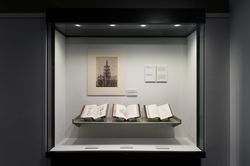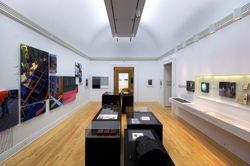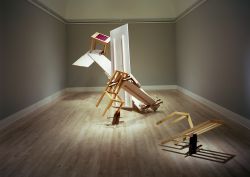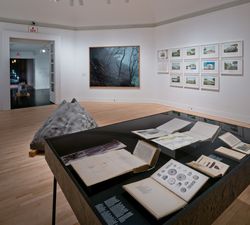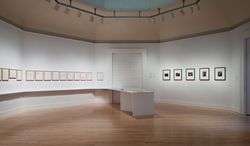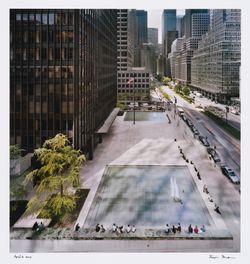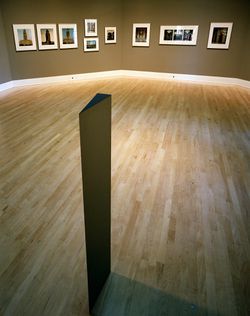The Anatomy of the Architectural Book, an exhibition presented in conjunction with the publication of a book of the same title by André Tavares, examines the relationships between book culture and building culture, making visible the axes along which architectural knowledge circulates through books into buildings and back. Through seven themes—Texture, Spread, Sequence,(...)
10 May 2016 to 20 November 2016
The Anatomy of the Architectural Book
Actions:
Description:
The Anatomy of the Architectural Book, an exhibition presented in conjunction with the publication of a book of the same title by André Tavares, examines the relationships between book culture and building culture, making visible the axes along which architectural knowledge circulates through books into buildings and back. Through seven themes—Texture, Spread, Sequence,(...)
Sense of the City
Sense of the City explores urban phenomena and perceptions of the city which have traditionally been ignored, repressed, or maligned. Challenging the dominance of the visual in the urban environment, the exhibition proposes a re-thinking of latent qualities of the city, offering complex analyses of the comforts, communication systems, and sensory dimensions of urban(...)
Main galleries
26 October 2005 to 10 September 2006
Sense of the City
Actions:
Description:
Sense of the City explores urban phenomena and perceptions of the city which have traditionally been ignored, repressed, or maligned. Challenging the dominance of the visual in the urban environment, the exhibition proposes a re-thinking of latent qualities of the city, offering complex analyses of the comforts, communication systems, and sensory dimensions of urban(...)
Main galleries
exhibitions
Learning Architecture
As architecture acquired its modern identity as both a liberal art and a regulated profession, and as architectural theories and forms underwent radical transformations, the training of architects did not fundamentally change. The core activities of architectural students remain “Authority,” the study of treatises and theoretical works, “Observation,” the study of the(...)
Hall cases
5 July 1994 to 2 October 1994
Learning Architecture
Actions:
Description:
As architecture acquired its modern identity as both a liberal art and a regulated profession, and as architectural theories and forms underwent radical transformations, the training of architects did not fundamentally change. The core activities of architectural students remain “Authority,” the study of treatises and theoretical works, “Observation,” the study of the(...)
exhibitions
5 July 1994 to
2 October 1994
Hall cases
Parables and Other Allegories: The Work of Melvin Charney 1975–1990 comprises approximately 100 drawings, including many large-scale, sketches, photographs, and three large constructions. By assembling works from various public and private collections, including the CCA, the exhibition permits a comprehensive analysis of Charney’s artistic process to reveal the dialogue(...)
Main galleries
9 October 1991 to 12 January 1992
Parables and Other Allegories: The Work of Melvin Charney, 1975-1990
Actions:
Description:
Parables and Other Allegories: The Work of Melvin Charney 1975–1990 comprises approximately 100 drawings, including many large-scale, sketches, photographs, and three large constructions. By assembling works from various public and private collections, including the CCA, the exhibition permits a comprehensive analysis of Charney’s artistic process to reveal the dialogue(...)
Main galleries
The exhibition explores one of the most adventurous and influential moments in the history of architecture: the explosion of invention and ideas that followed the October Revolution in Russia. The Soviet avant-garde architects were productivist as much as aesthetic in their concerns; they saw architecture and the arts as one, and they were committed to bringing design(...)
Main galleries
19 June 1991 to 8 September 1991
Architectural Drawings of the Russian Avant-Garde, 1917-1935
Actions:
Description:
The exhibition explores one of the most adventurous and influential moments in the history of architecture: the explosion of invention and ideas that followed the October Revolution in Russia. The Soviet avant-garde architects were productivist as much as aesthetic in their concerns; they saw architecture and the arts as one, and they were committed to bringing design(...)
Main galleries
Between 1836 and 1848, the German-Dutch explorer Franz Wilhelm Junghuhn made several expeditions in Java in the service of the Dutch colonial authorities. He was among the first colonists to climb the island’s many volcanoes. His scientific works, books, maps, and lithographs made him the “Humboldt of Java.” This exhibition follows Junghuhn’s footsteps and explores(...)
Octagonal gallery
29 September 2016 to 22 January 2017
17 Volcanoes: Works by Franz Wilhelm Junghuhn, Armin Linke, and Bas Princen
Actions:
Description:
Between 1836 and 1848, the German-Dutch explorer Franz Wilhelm Junghuhn made several expeditions in Java in the service of the Dutch colonial authorities. He was among the first colonists to climb the island’s many volcanoes. His scientific works, books, maps, and lithographs made him the “Humboldt of Java.” This exhibition follows Junghuhn’s footsteps and explores(...)
Octagonal gallery
Portuguese architect Álvaro Siza travelled to Peru in 1995 with his usual baggage: only a few changes of clothes, some books of poetry, and a single sketchbook. This was the toolkit he used to interpret the voyage and integrate it into his architecture. More than half a century earlier, Peruvian photographer Martín Chambi had taken his famous series of portraits of the(...)
Octagonal gallery
26 January 2012 to 29 April 2012
Alturas de Machu Picchu: Martín Chambi – Álvaro Siza at work
Actions:
Description:
Portuguese architect Álvaro Siza travelled to Peru in 1995 with his usual baggage: only a few changes of clothes, some books of poetry, and a single sketchbook. This was the toolkit he used to interpret the voyage and integrate it into his architecture. More than half a century earlier, Peruvian photographer Martín Chambi had taken his famous series of portraits of the(...)
Octagonal gallery
Seagram Plaza
The plaza at the Seagram Building in New York, designed by Ludwig Mies van der Rohe and completed in 1958, was a litmus test of what an open space in the city could be. Raised three steps above the sidewalk along Park Avenue, the plaza is an oasis of calm, distant from the commotion and turbulence of the street. The way in which the plaza has been adopted by New Yorkers(...)
Hall cases
1 May 2013 to 18 August 2013
Seagram Plaza
Actions:
Description:
The plaza at the Seagram Building in New York, designed by Ludwig Mies van der Rohe and completed in 1958, was a litmus test of what an open space in the city could be. Raised three steps above the sidewalk along Park Avenue, the plaza is an oasis of calm, distant from the commotion and turbulence of the street. The way in which the plaza has been adopted by New Yorkers(...)
Hall cases
Twenty-two colour photographs reveal Ernest Cormier’s central pavilion of the Université de Montréal as an integral part of the Montréal urban landscape and as a complex, varied spatial experience. The exhibition originated in a commission to Gabor Szilasi by the CCA when research into the Fonds Cormier revealed a major gap in the photographic documentation of the(...)
Octagonal gallery
2 May 1990 to 28 October 1990
Sighting the Université de Montréal: Photographs by Gabor Szilasi
Actions:
Description:
Twenty-two colour photographs reveal Ernest Cormier’s central pavilion of the Université de Montréal as an integral part of the Montréal urban landscape and as a complex, varied spatial experience. The exhibition originated in a commission to Gabor Szilasi by the CCA when research into the Fonds Cormier revealed a major gap in the photographic documentation of the(...)
Octagonal gallery
At the beginning of powered flight, most airplanes required only a stretch of grassy plain 1,500 feet long for take-off and landing, and a converted barn served as both terminal and hangar. Only with the advent of a profitable commercial aviation industry in the late 1920s, some twenty-five years after Wilbur and Orville Wright’s historic flight, did the modern airport(...)
Hall cases
12 June 1990 to 16 September 1990
Airport Origins: Three Projects by Lloyd Wright
Actions:
Description:
At the beginning of powered flight, most airplanes required only a stretch of grassy plain 1,500 feet long for take-off and landing, and a converted barn served as both terminal and hangar. Only with the advent of a profitable commercial aviation industry in the late 1920s, some twenty-five years after Wilbur and Orville Wright’s historic flight, did the modern airport(...)
Hall cases
